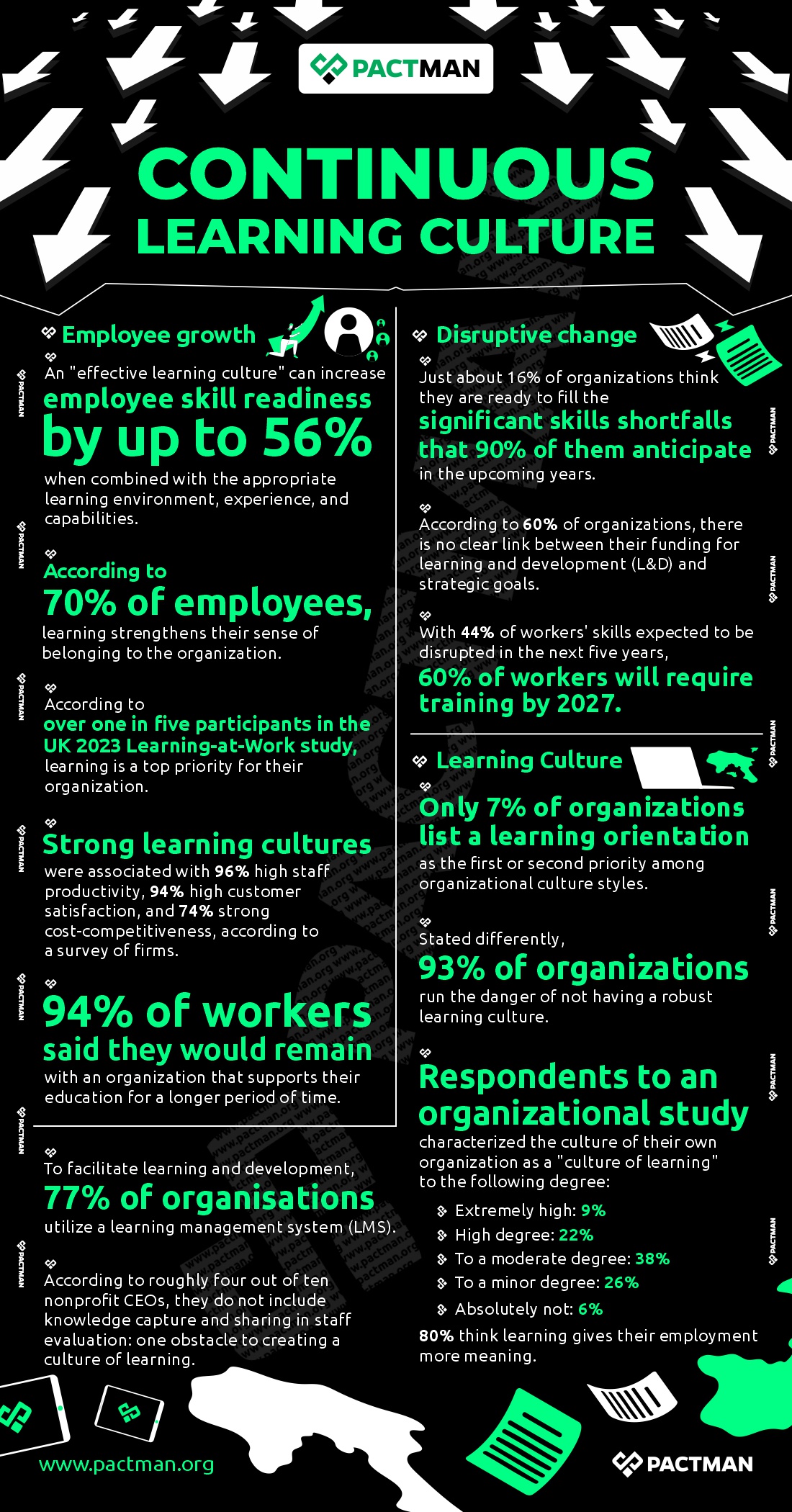I
Introduction
To foster a culture of continuous learning, an organization must create an environment where inquiry, introspection, and evidence-based decision-making are regular practices rather than one-time occurrences. For foundations, the priority should be to develop the right culture rather than merely adopt a new approach.

If learning is viewed solely as a programmatic approach or a managerial role, it may be neglected or eliminated when budgets become tight. Now more than ever, philanthropy is becoming increasingly recognized as a key component of the nonprofit’s dual mission: program execution and philanthropic excellence. Hence, if the main objective entails the efficient use of capital for long-term impact, the mechanisms that guarantee efficiency must also be mission-critical. These mechanisms may include learning, adaptation, and improvement.
All in all, learning is no longer negotiable when it is ingrained as a fundamental cultural value that directs resource allocation and daily conduct. It helps transform learning from an administrative obligation into a genuinely moral and strategic necessity for optimizing future impact. The step-by-step, straightforward methods described in this article can help any foundation implement a continuous learning culture regardless of size or purpose.
II
Recognizing the Essential Components of a Continuous Learning Culture
A Continuous Learning Culture (CLC) is characterized by common values, expectations, and practices that prioritize knowledge acquisition at every level of the organization. Even more, CLC empowers and encourages employees to constantly seek out and exchange knowledge and skills. For foundations and grantmaking organizations to stay competitive, creative, and profoundly relevant to the intricate social issues they tackle, this kind of environment is not just a contemporary organizational trend.

Also, a culture of continuous learning extends beyond yearly retreats and post-project evaluations. Rather, it is a system that incorporates learning into routine tasks, such as stakeholder interaction, grant assessments, and strategic planning. Basically, it’s about:
- Urging people to consider all available options before making judgments.
- Thinking back on both achievements and setbacks.
- Transferring knowledge between partners and divisions.
- Directing future activities with data and insights.
When implemented properly, this culture creates a company that is more socially impactful, stays innovative, and changes more quickly. More often than not, it takes time to establish a culture of learning. This is because it calls for routines, leadership, and structure. Here are the crucial pillars listed below for effective implementation:
a. Leadership Dedication
Leaders need to be personally curious. Also, executives prove that they appreciate learning when they actively seek feedback and acknowledge that they don’t have all the answers. Leaders should be able to:
- Talk candidly about the lessons they’ve learnt.
- Teams should be rewarded for trying new things and making data-driven changes.
- Establish regular time slots for learning.
b. A Secure Environment for Introspection
Sharing lessons, especially from unsuccessful endeavors, requires a sense of security. A “no-blame” attitude promotes psychological safety and open communication.
c. Systems for Knowledge Sharing
If learning is restricted to one area, it loses value. Hence, it is best to create platforms and tools (such as learning databases, internal newsletters, or shared dashboards) that facilitate the sharing and easy access of insights.
d. Integration of Data and Evaluation
Data collection and evaluation ought to be directly connected to learning. Consider every grant report, monitoring system, or feedback survey as an opportunity to grow and learn.
e. Learning Resources and Time
Set aside time for educational pursuits. Teams can benefit from even a brief monthly “learning hour” to discuss emerging industry trends, exchange experiences, and consider recent discoveries.
III
Critical Statistics on Continuous Learning
In this section, we will consider critical statistics on continuous learning and its implementation across organizations.
a. Employee growth
An “effective learning culture” can increase employee skill readiness by up to 56% when combined with the appropriate learning environment, experience, and capabilities. According to 70% of employees, learning strengthens their sense of belonging to the organization.
According to over one in five participants in the UK 2023 Learning-at-Work study, learning is a top priority for their organization. Strong learning cultures were associated with 96% high staff productivity, 94% high customer satisfaction, and 74% strong cost-competitiveness, according to a survey of firms. According to a global culture survey, workers who say their culture is “good” or “excellent” are much more likely to be content and much less likely to be looking for a job.
94% of workers said they would remain with an organization that supports their education for a longer period of time. According to 70% of employees, learning strengthens their sense of belonging to the company.

b. Disruptive change
Just about 16% of organizations think they are ready to fill the significant skills shortfalls that 90% of them anticipate in the upcoming years. According to 60% of organizations, there is no clear link between their funding for learning and development (L&D) and strategic goals. With 44% of workers’ skills expected to be disrupted in the next five years, 60% of workers will require training by 2027.
c. Learning Culture
Only 7% of organizations list a learning orientation as the first or second priority among organizational culture styles. Stated differently, 93% of organizations run the danger of not having a robust learning culture. Respondents to an organizational study characterized the culture of their own organization as a “culture of learning” to the following degree:
- Extremely high: 9%
- High degree: 22%
- To a moderate degree: 38%
- To a minor degree: 26%
- Absolutely not: 6%
80% think learning gives their employment more meaning. To facilitate learning and development, 77% of organisations utilize a learning management system (LMS). According to roughly four out of ten nonprofit CEOs, they do not include knowledge capture and sharing in staff evaluation, one obstacle to creating a culture of learning.
IV
A Methodical Approach to Establishing a Learning Culture
In this section, we will consider an effective approach to establishing a learning culture within a grantmaking foundation.

1. Psychological Safety and Growth Mindset Development
Without a conducive learning environment, which is centered on psychological safety, a learning culture cannot flourish. Risk-taking, error-making, and failure are all necessary for learning. Many organizational leaders agree that learning from mistakes is essential. However, very few can successfully change their culture to one where the benefits of doing so may be fully realized.
To begin with, leaders must aggressively encourage employees to take calculated risks and accept failure through structured reflection and safe dialogue. This method, sometimes referred to as “Failing Forward,” sees errors as crucial opportunities for growth rather than as failures. Building the trust necessary for grantees to openly share their challenges requires the grantmaking foundation to first model vulnerability internally. This is by sharing lessons gained from its own mistakes and aggressively seeking feedback. Primarily, this is the first step towards implementing trust-based philanthropy.
2. Institutionalizing Learning Across Roles
Secondly, executives must be the first to demonstrate commitment and set an example for a Continuous Learning Culture. Leaders operate as the main role models, outlining the goal in detail and actively motivating employees to look for new development opportunities. This conduct needs to go beyond verbal encouragement to include structural dedication.
One of the organization’s key values should be learning, according to business leaders. Also, making learning a cornerstone of the foundation’s identity guarantees that investments in learning and development (L&D) are not viewed as an afterthought or disposable item when important financial decisions are being made. This dedication is directly translated into systemic assistance that helps navigate beyond typical obstacles to motivation, such as employees not seeing the value of training.
On the other hand, staff members are inspired when they realize that the institution is dedicated to their long-term development and career path. Furthermore, it emphasises a priority when leadership is actively safeguarding and funding high-quality L&D.
3. Integrating Education into the Grantmaking Process
Fundamentally, a CLC calls for a change in the grantmaker-grantee relationship from one centered on transactional compliance to one centered on relational partnership and shared learning. This change necessitates that donors ask different questions than those that are only concerned with traditional accountability metrics and actively listen to grant recipients from the beginning.
In order to achieve long-term impact, the focus of accountability shifts from strict short-term compliance inspections to shared learning through the implementation of a trust-based evaluation framework. Likewise, grantees are empowered to be more open about their work when grantors embrace vulnerability and are flexible with timetables and initial anticipated results. It is therefore necessary to redesign the reporting process so that it serves as a fundamental learning tool and not just a compliance burden.
4. Setting Goals Together and Having Flexible Reporting
The realization of emergent learning is achieved through teamwork. To create a “living project framework” at the start of a grant partnership, the foundation and grantee should collaborate. Grantees can specify
- what they want to change,
- how they will measure that change, and
- how they will report in this co-creation process.
Additionally, foundations should incorporate flexibility into project schedules to accommodate time for reflection sessions and exploratory discussions. Using action-oriented Learning Communities (LCs) with grantmakers and grantees is a great way to support emergent learning.
To avoid the impression that participation is an “add-on,” successful learning Cultures must be structured as working groups devoted to addressing specific, collaboratively determined issues that propel the grantees’ current work. Certain design components are necessary to keep LCs from becoming ineffectual or inward-focused:
- The use of knowledgeable facilitators who lead the group and maintain accountability (sometimes via a shared “compact”), and
- Recurring contributions from outside experts, like academic researchers, to improve learning and bring in external viewpoints.
Conclusions
In summary, the best long-term investment a foundation can make in its goal is to foster a culture of continual learning. It is the system that guarantees strategic relevance, organizational health, and maximum societal impact that goes beyond basic grantmaking efficiency.
Even more, creating a culture of continual learning within a foundation requires a mental shift rather than a one-time endeavor. It entails seeing every task, discussion, and result as an opportunity to develop and learn.
When learning is integrated into a foundation’s operations rather than merely its activities, it develops more quickly, increases its influence, and fosters trust among communities and partners.


